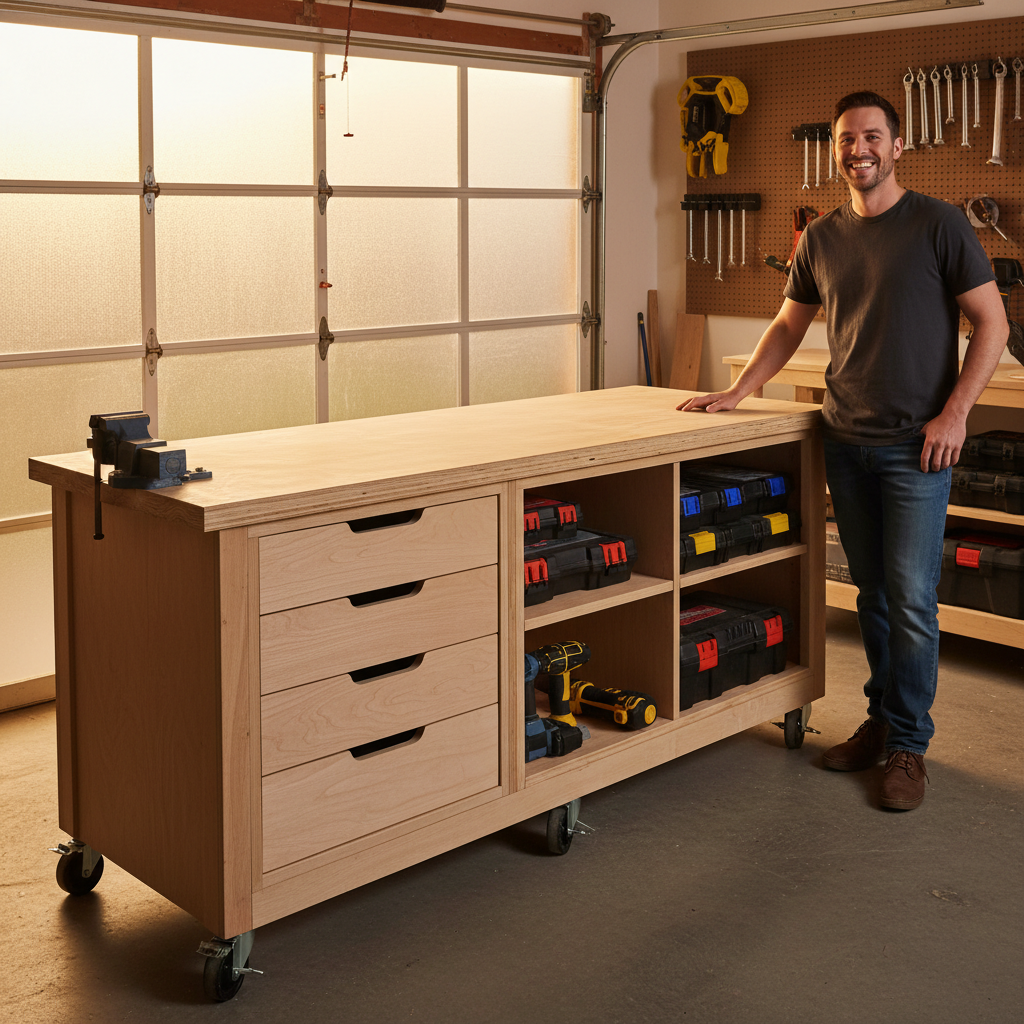Ever feel like your home shop is fighting against you? You’re trying to tackle a woodworking project, but your bench is stuck in the corner, blocking access to your tools. Then you switch to a metalworking task, and suddenly, you need a different setup entirely. Sound familiar? I’ve been there, pulling my hair out trying to make a static, one-size-fits-all workbench work for a dynamic, multi-purpose shop. That’s when I had my “aha!” moment: a modular, mobile workbench with casters was the answer to all my space and flexibility woes.
If you’re tired of tripping over tools, wishing you had more elbow room, or constantly re-arranging your entire shop for every new project, then you’re in the right place. In this guide, I’m going to walk you through my journey of building a workbench that doesn’t just sit there – it moves, adapts, and makes your work life so much easier. We’ll cover everything from plaing to putting on those crucial casters, all based on what I learned (and occasionally messed up!) along the way. Get ready to transform your workspace!
Why Go Modular and Mobile? My Personal Eureka Moment
For years, my garage served a dual purpose: car parking and a sporadic workshop. This meant my beautiful, sturdy, but utterly immovable workbench was often more of an obstacle than an asset. I’d be working on a long piece of wood, needing space on both ends, but my bench was snug against the wall. Or, I’d need to wheel my planer over to the bench, but the bench wouldn’t budge. The frustration was real.
My “eureka moment” came during a particularly challenging furniture build. I needed to assemble a large cabinet, and I kept having to walk around my fixed bench to access different sides. It was inefficient, tiring, and frankly, a little dangerous. I realized I wasn’t just building a workbench; I was building a system that needed to adapt to *my* projects, not the other way around. Here’s why going modular and mobile was a game-changer for me:
- Space Optimization: My garage is multi-purpose. Being able to tuck the workbench away or move it against a wall wheot in use, or even roll it outside for dusty tasks, frees up invaluable floor space.
- Adaptability for Different Projects: One day I’m sanding, the next I’m welding. A modular design means I can configure tool storage, add a dedicated router table insert, or even swap out a work surface for specific tasks.
- Improved Workflow: I can position my workbench exactly where I need it. Need to bring it closer to the dust collector? Done. Need to work under natural light by the garage door? No problem. This dramatically improves my efficiency and reduces uecessary movement.
- Better Ergonomics: My back thanks me. No more awkward reaches or bending because the bench is in the wrong spot. I can adjust my position relative to the work, not the other way around.
- Enhanced Safety: Moving heavy lumber or sheet goods around a fixed bench is risky. With a mobile bench, I can bring the work surface to my material, or vice-versa, with much less strain and greater control.
Plaing Your Dream Workbench: More Than Just Wood and Wheels
Before you even think about cutting your first piece of wood, plaing is absolutely crucial. Trust me on this one; I’ve learned the hard way that a little extra time spent plaing saves a lot of headaches (and wasted material) during the build. Think of your workbench as an extension of your creative process.
Key Considerations for Your Design:
- Size and Footprint: How much space do you realistically have? What’s the largest project you anticipate tackling? I recommend mapping it out on your garage floor with painter’s tape to get a real feel for the dimensions. My bench is roughly 6 feet long by 30 inches deep, a sweet spot for my space.
- Height: This is an ergonomic game-changer. Do you primarily stand or sit while working? Consider your own height. A common height for standing work is around 34-36 inches. I built mine at 36 inches, which is perfect for me. You might even consider an adjustable height mechanism if your budget allows.
- Materials:
- Plywood: For the main carcass, shelves, and even the top, 3/4″ Baltic Birch or good quality ACX plywood is a fantastic choice. It’s strong, stable, and relatively affordable.
- 2x4s or 4x4s: Great for sturdy legs and a robust frame, especially if you’re plaing on heavy-duty use.
- MDF: Good for drawer bottoms, sacrificial tops, or jigs, but less durable for heavy-duty surfaces.
- Casters: This is non-negotiable for a mobile bench!
- Locking Casters: Get four of them, and make sure they lock both the swivel and the wheel. You do NOT want your bench rolling away mid-cut.
- Weight Capacity: Overestimate the weight. My bench, fully loaded with tools and material, is heavier than you might think.
- Wheel Material: Polyurethane wheels are great for most concrete garage floors, as they roll smoothly and won’t mar the surface.
- Modularity: This is where your personal workflow comes in. Do you need dedicated drawer banks? Open shelving for bins? A specific spot to mount a vice or a bench grinder? Think about creating compartments that can be reconfigured or swapped out.
- Budget: Be realistic. Good materials and hardware aren’t free, but investing upfront saves money and frustration down the line.
Gathering Your Arsenal: Tools and Materials You’ll Need
Before you dive in, make sure you have the right tools and materials. This isn’t an exhaustive list, but it covers the essentials I used for my build:
Tools:
- Measuring & Marking: Tape measure, pencil, speed square, combination square.
- Cutting: Circular saw (with a good quality blade and a straight edge guide for plywood breakdown), or a table saw if you have one. Miter saw for cutting frame members to length.
- Drilling & Driving: Cordless drill/driver, various drill bits (pilot holes are your friend!), countersink bit.
- Joinery: A pocket hole jig (like a Kreg Jig) makes carcass construction incredibly fast and strong for plywood.
- Clamping: Essential for glue-ups and holding pieces steady. Get a variety of sizes.
- Safety Gear (Non-Negotiable!): Safety glasses, hearing protection, dust mask.
- Optional (but Recommended): Router for rounding over edges or cutting dados, random orbital sander for finishing.
Materials:
- Plywood: Several sheets of 3/4″ plywood (depending on your design and size). I used about two and a half 4×8 sheets for my 6×2.5 ft bench with a few drawers and a shelf.
- Dimensional Lumber: 2x4s or 4x4s for legs if you want extra beefy support.
- Casters: Four heavy-duty, double-locking swivel casters (e.g., 4-inch diameter with a 200-300lb capacity EACH).
- Fasteners: Wood screws (e.g., 2.5-inch for framing, 1.25-inch for thier plywood), pocket hole screws (if using a jig).
- Adhesive: Good quality wood glue.
- Drawer Slides: If adding drawers (full extension are worth the extra cost).
- Finishing: Sandpaper (various grits), polyurethane or other durable clear coat.
- Optional: Power strip, pegboard, T-track, bench vice, lighting.
The Build Journey: Step-by-Step (My Simplified Approach)
Here’s a general overview of how I approached building my modular workbench. Remember, this is a guide, not a strict blueprint – feel free to adapt it to your specific needs and tools!
Step 1: Frame Construction
I started by building two identical frames for the top and bottom of the bench. I cut my long rails and shorter stretchers from 3/4″ plywood strips (or 2x4s if you prefer dimensional lumber) and joined them with pocket holes and wood glue. The key here is to make sure these frames are perfectly square. A solid, square foundation prevents racking and wobbles later on.
Step 2: Adding Legs and Bottom Shelf
Once my frames were assembled, I attached the legs. I opted for simple 3/4″ plywood panels for the legs, effectively creating two end cabinets, which added a ton of rigidity and gave me vertical surfaces for attaching modules later. I then installed a lower shelf coecting these legs, which significantly stiffens the entire structure and provides valuable storage space for heavier items like toolboxes or lumber cut-offs.
Step 3: Workbench Top
For the top, I used two layers of 3/4″ plywood laminated together with wood glue. This creates a very thick, stable, and durable work surface that can handle clamps, pounding, and general shop abuse. I applied wood glue generously, spread it evenly, and then screwed the two layers together temporarily while the glue dried (removing the screws later, or countersinking and filling them). I then added an edge banding of solid wood (or another strip of plywood) around the perimeter. This protects the plywood edges and gives the top a cleaner, more finished look.
Step 4: Caster Installation – The Freedom Factor!
This is where the magic happens! I mounted my heavy-duty locking casters to the bottom corners of the workbench base. Make sure to use appropriate bolts or lag screws that are long enough to penetrate well into the frame, and use washers to distribute the load. Test each caster’s locking mechanism to ensure it holds firm. This step alone transformed my shop, giving me the freedom to move the bench with just a gentle push.
Step 5: Building Modules (The Fun Part!)
With the basic bench structure complete and mobile, it was time to add the “modular” elements. This is where you truly customize it to your workflow:
- Shelves: Simple plywood shelves (adjustable, if possible) are great for tool bins, project parts, or frequently used items.
- Drawers: I built a small bank of drawers on one side for smaller tools, fasteners, and hardware. Don’t skimp on full-extension drawer slides; they make a huge difference in accessibility.
- Tool Storage: On the plywood leg panels and along the back, I installed French cleats and pegboard panels. This allows me to hang hand tools, power tools, and custom jigs, keeping them organized and easily accessible.
- Bench Vice Mount: I integrated a beefy mounting plate for my bench vice, ensuring it was incredibly stable when clamped down.
- Router Plate Insert: On one end of the bench, I routed a recess for a removable router plate, effectively turning a section of my workbench into a router table wheeeded.
Step 6: Finishing Touches
Finally, I sanded all surfaces smooth and applied several coats of a durable polyurethane finish to the top and exposed plywood edges. This protects the wood from spills, glue, and general wear and tear. I also added a power strip along the back of the bench for easy access to outlets – a small but mighty convenience!
My Top Tips for a Successful Build and a Happier Shop
Based on my experience, here are a few nuggets of wisdom:
- Don’t Rush the Plaing: Seriously, sketch it out, measure your space, and think about your workflow. It’s the most important step.
- Measure Twice, Cut Once: The age-old adage is true. Especially with plywood, a wrong cut is an expensive mistake.
- Invest in Good Casters: This is not the place to save a few bucks. Heavy-duty, double-locking casters are worth every pey for safety and functionality.
- Think About Future Expansion: Even if you don’t build every module now, design your base to accommodate additions later. Leave some room for a future drawer bank or tool storage unit.
- Safety First, Always: Wear your PPE. Use clamps. Work smart.
- Don’t Be Afraid to Adapt: Your plan is a guide, not a prison sentence. If something isn’t working during the build, adjust! That’s the beauty of DIY.
Your Shop, Transformed!
Building my modular, mobile workbench was one of the most rewarding projects I’ve undertaken for my home shop. It completely transformed how I work, making my space more organized, efficient, and enjoyable. No more wrestling with heavy projects, no more static limitations – just pure, unadulterated flexibility. If you’ve been on the fence about tackling this project, I wholeheartedly encourage you to go for it. You’ll gaiot just a fantastic workbench, but also a deeper understanding of your own shop needs and building capabilities. Get out there, build something amazing, and unlock your shop’s true potential!



